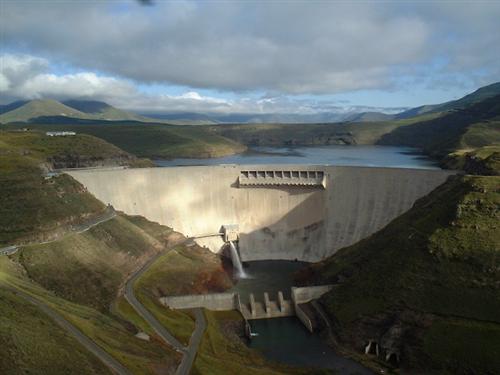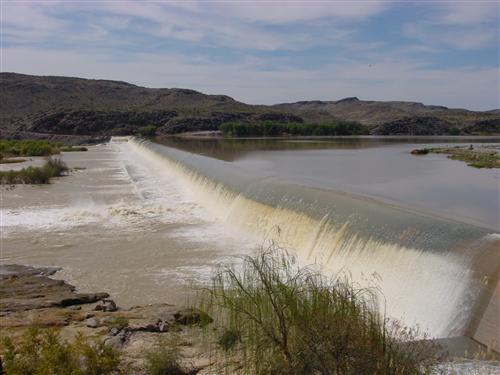In addition to eutrophication, a significant threat to aquatic ecosystems in southern Africa (and elsewhere) lies in the invasive species Water Hyacinth (Eichhornia crassipes) and Water Fern (Azolla filiculoides). These aquatic plants, native to South America, have invaded numerous sections of the Vaal River. While Water Fern is limited to the upper catchments of the Vaal River, Water Hyacinth is found in the upper-middle Vaal and extends as far as Douglas Weir. Biological control agents, including the weevil, Stenopelmus rufinasus, has been relatively successful in controlling the spread of invasion; however, they continue to spread, with Water Hyacinth now occasionally found in the lower reaches of the main-stem Orange-Senqu River.
Other introduced species include two species of trout (Salmo trutta and Oncorhynchus mykiss). Originally introduced for sport fishing in South Africa, they have affected populations of indigenous minnow species in Lesotho and South African portions of the Orange-Senqu River basin, and are found throughout the basin, albeit in smaller numbers, from the Maluti Mountains downstream to the Gariep and Vanderkloof dams.
Other factors affecting aquatic ecosystems are listed in the table below. They are discussed in detail in the water quality chapter of this theme.

Dam management practices have a significant influence on stream flow in the basin.
Source:Pyke 2001
( click to enlarge )
Table: Factors affecting aquatic ecosystems.
|
Factor
|
Impact
|
|
Alien species
|
Pioneer alien species out-compete indigenous species for space, nutrients and sunlight
|
|
Dams, inter-basin transfers, hydro-electrical flow releases, irrigation and mining abstraction
|
Modified flow regime or hydrology
|
|
Pollution from mines and return flows from irrigation
|
Reduction in water quality, including nutrient build-up and salanisation
|
|
Reduced flood regime and modified seasonal flows
|
Geomorphologic modification of the river channel due to lower flows, resulting in less or no scoured
|
|
Riparian and in-stream vegetation is harmed and continues to deteriorate
|
Floating aquatic plants increase with reduced flow
|
|
Changes to the shape of the wetted perimeter of the river channel, with lower water levels causing banks to dry out, temporary exposure of unprotected banks and bank collapse
|
|
Enhanced benefit to pioneer reeds, such as the Common Reed (Phragmites australis), under reduced flow, with increased distribution and patch size, thereby accumulating sediments, blocking channels and resulting in large disturbances when washed out during large floods. These often form reed mats that cause blockages downstream and exacerbate the effect of floods.
|
|
Loss of indigenous trees and gallery forest in the riparian belt because of reduced floods (moisture), reduced seed dispersal, more frequent hot fires because of increase in reed beds and less cooling effect as previously moist riverbanks are drier
|
|
Increased agricultural encroachment into the riparian belt because of reduced flooding and waterlogged soils
|
|
Invasion by alien vegetation, notably Mesquite (Prosopis spp.), exacerbated by a loss of indigenous vegetation and disturbance (e.g., through fires and agricultural activities)
|
|
Changes in species composition and abundance as a result of fertilizers and salts draining into the river, with for example Common Reed (P. australis) and Wild Tamarisk (Tamarix usneoides) increasing and having a negative effect on safsaf willow, Kaapse wilger or Cape Willow (Salix mucronata).
|
Source: UNDP-GEF (2008)
Environmental Flows
The aquatic environment should always be considered as a legitimate consumer of water, whose requirements must be met alongside basic human requirements, and ahead of any other demand. In the case of water projects involving impoundment, this translates to maintenance of flow in the reaches of the river downstream of the impounding structure, dam, or diversion. Environmental flows are required to:
-
Maintain the riverine ecology
-
Recharge riverine aquifers
-
Maintain the river channel
For a detailed discussion of environmental flow requirements in the Orange-Senqu River basin and the relevant legislation see Environmental Flows in the Resource Management chapter.

Maintaining environmental flows is important to support healthy ecosystems - Boegoeberg Dam.
Source:Source:DWAF South Africa 2002
( click to enlarge )
